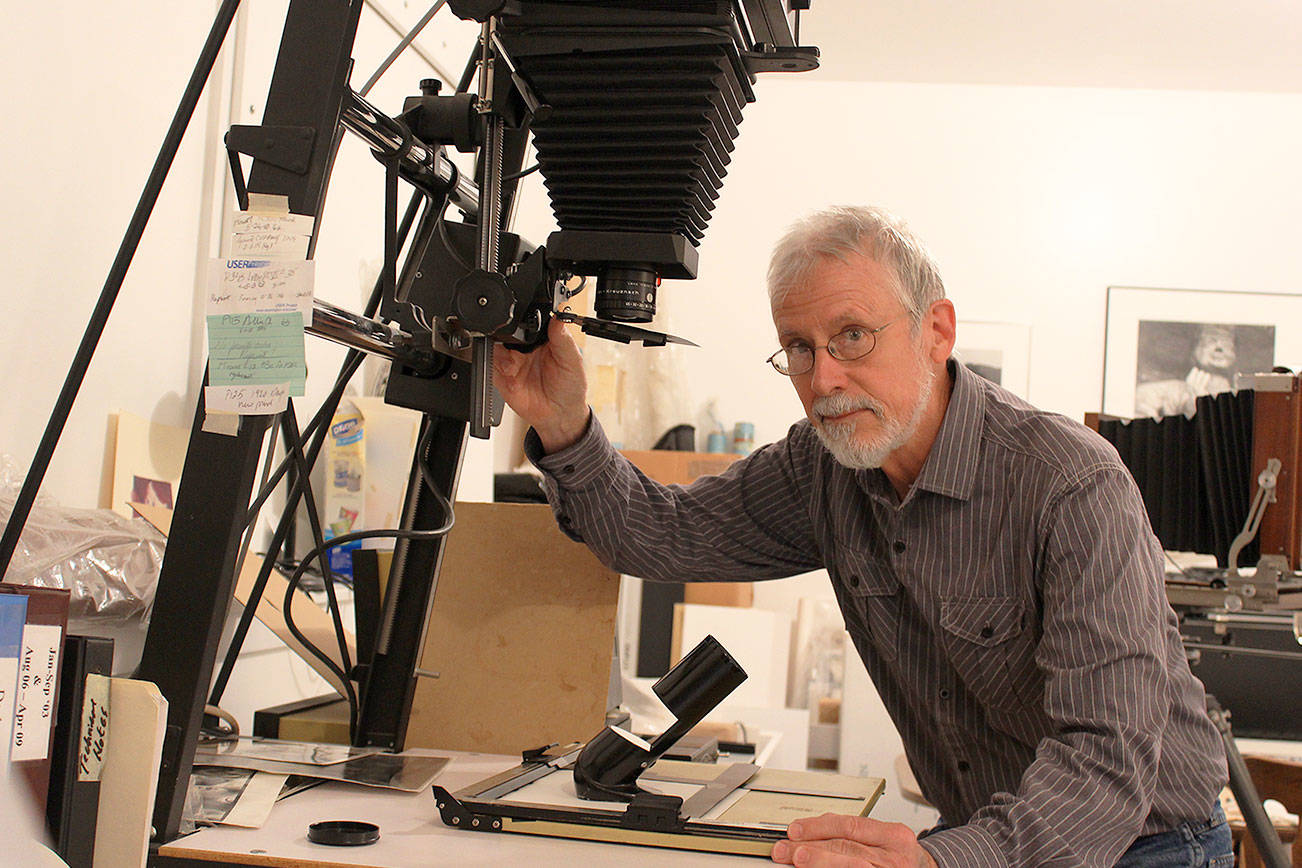When John Olsen moved from the Southwest to the Northwest in 2007, he couldn’t see the forest through the trees.
Or at least, his camera lens couldn’t.
“I had to change my film and processing,” he says. “Everything is green, green, green. It looked like it was all one tone of gray so I had to switch over to slightly more infrared film that would distinguish between the greens.”
Funny thing is, there’s no greens in Olsen’s photographs featured this month at Artworks Gallery in Greenbank.
And there’s no reds, blues, yellow or any color, for that matter.
Olsen specializes in composition — from the weathering wood of Whidbey barns to the concrete bunkers of Fort Casey to the intricate chrome parts of a Harley-Davidson motorcycle engine.
In Olsen’s eye, detail is best achieved in tones of black and white.
Color is pretty but it’s distracting.
It pops, sure, but it doesn’t contemplate.
“You want to knock it down to composition as opposed to a pretty postcard,” says the 73-year-old Coupeville resident who calls his fine arts photography an expensive passion, one that’s equipped with a first-floor studio and darkroom in his house near Fort Ebey State Park.
Olsen traded sagebrush, dust devils and the subtle tones of high-desert browns for the evergreen of Washington state when his wife, Christine Laing, wanted to move back to her roots. She grew up in Bellevue and attended college at Fairhaven.
They had lived in Denver and Albuquerque for more than three decades. Olsen worked as a physicist at Sandia National Laboratories, the nation’s premier science and engineering laboratory for national security and technology.
Olsen strives for contour, contrasts, subtlety, simplicity in his photos. He uses a variety of large format cameras that are bulky, heavy and require patience, precision and the personal touch of developing images of light in a darkroom.
His black-and-white images of Whidbey’s historical farms, fields and forts are labeled “photo monoprints” at the Artworks Gallery because they are truly one of a kind.
While many artists claim their works are unique, never-to-be-reproduced original creations, Olsen’s photos taken with his homemade pinhole camera really are.
It uses rare, no longer available paper that he saved a supply of years ago. He then directly processes a 4×5 image onto it. It’s called a direct positive process because there’s no negative.
Just one image.
Since moving to Whidbey in 2007, Olsen has taken many photographic tours of the island’s iconic scenes – old boats, leaning shacks, fading steps, forlorn farm houses. Searching for a new approach this winter, he remembered the large format pinhole camera he’d constructed decades ago but hadn’t touched in 20 years.
“So here it is,” he says, delicately removing the “lens cap” an old Air Force beret. He peers into the “camera” — a 36-ounce brown Maxwell House coffee can (circa 1993) — and describes its parts.
“The aperture is a 0.020-inch needle-drilled hole in brass shim stock. With a 5-inch pinhole-to-film distance, this equates to an f-stop of 250.”
Translation: The inside of the coffee can is spray painted black and has a slightly curved film/paper holder glued onto it where the 4×5 inch paper is placed. A tiny pinprick hole is surrounded by black duct tape and acts as a lens.
“Large format pinhole camera images of Whidbey Island scenes offer a new way to appreciate our historic area. The paper makes a finished, one-off print. While this is convenient, it has a narrow dynamic range — each try is literally a shot in the dark.”
Translation: Lucky for Olsen, this unusual technique works best on overcast days because the less bright light the better. He got one chance to take one shot of Whidbey’s iconic images, and went back again and again until he got “it right.”
“I decided to do this series on overcast, low-contrast days to maximize my chances of success. I’d take the shot, drive home, unload and process it but I had no way of knowing how long to process. Exposures could be 8 minutes to 57 minutes depending upon our winter gloom.”
Beautiful shots. But only one of each. No negatives exist, they can’t truly be reproduced.
True, they could be scanned, digitized and endlessly copied on the computer. And posted, liked, linked, clicked, Instagrammed, tweeted and turbo-charged around the globe.
But that’s not art. That’s….well, not a path for John Olsen.
“There’s not a lot of us using large photographic format cameras,” he says. “But people tell me all the time at art shows that they really like black and white photographs. Then they turn around and buy a nice watercolor.
“But it’s important for me to show my work. Otherwise, you’re just messing around in the dark.”
• John Olsen’s work is featured at Artworks Gallery, 765 Wonn Rd, #C102, Greenbank. Phone: (360) 222-3010 and online at www.johnolsenphoto.com



